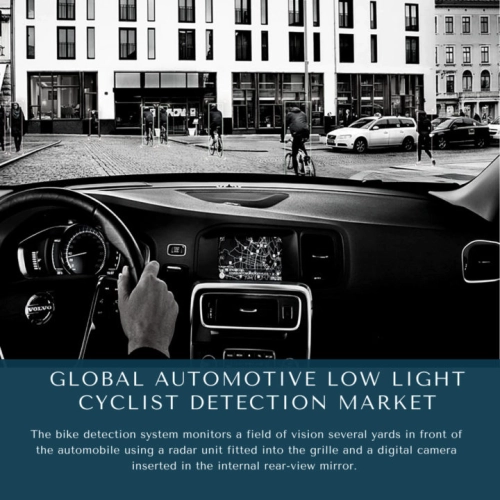
- Get in Touch with Us

Last Updated: Apr 26, 2025 | Study Period: 2024-2030
The bike detection system monitors a field of vision several yards in front of the automobile using a radar unit fitted into the grille and a digital camera inserted in the internal rear-view mirror.
The information both from sensors is delivered to a centralized controller, which can differentiate and classify the moving objects characteristics such as size as well as velocity in relation to the automobile. Both the radar as well as the cameras can follow people and bicycles as they pass along their projected trajectories.

| S No | Overview of Development | Development Detailing | Region of Development | Possible Future Outcomes |
| 1 | Volvo Launches World's First Cyclist Detection System In Geneva | The package will be termed "Pedestrian and Cyclist Detection with Full Auto Brake," and the additional capabilities will be an augmentation of the present recognition and automated brake technologies. | Global | This would enhance better Technological Controls |
| 2 | New technology allows smart cars to detect hidden pedestrians and cyclists | Engineers in Australia have created new technology that allows self-driving cars to follow running people concealed behind buildings and bicycles dwarfed by larger vehicles. | Global | This would enhance better Technological Controls |
| 3 | Autonomous Emergency Steering (Aes) Applies A Small But Rapid Steering Input To Avoid The Collision | Euro NCAP evaluates many situations in which a bicycle crosses the path of the test vehicle for cyclist detection: The cyclist is ahead of the automobile and coming from the near side, and if the driver does not take action to avoid the accident, the rider will be struck. | Global | This would enhance better Technological Controls |
| 4 | Car Makers Told To Fit Cyclist Detection Systems To Save Lives | Nissan Leaf is the first car to be tested to Euro NCAP's new benchmark with bicycle identification. | Global | This would enhance better Technological Controls |
| 5 | Researchers develop alert system to protect cyclists from cars | Rajamani and his colleagues are working on a smart bicycle with an integrated alarm system that sounds a horn when motorists approach the biker too closely. | Global | This would enhance better Technological Controls |
Very recent times, radar detectors and small cameras installed on vehicles were largely employed to monitor the location and speed of huge, solid objects in front of the vehicle.
Throughout the last decade, great progress has been made in perception detection and tracking, resulting in active pedestrian safety systems being installed in the majority of mid- to high-end vehicles on the market.
Vision-based bicycle identification has received very little attention, especially when it comes to quantitative performance assessment on huge datasets.
Volvo Group is a prominent developer of the latest integrated technologies focusing on better smarter sensing focused on spectrum of automotive improvisation integration for the future.
The Collision Warning featuring Autonomous Brake and Cyclist and Person Detection helps the motorist avoid colliding with either a human, cyclist, or automobile in front of them that is either stopped or heading the same way.
The platform's optimal attribute set that the runtime environment that senses a cyclist expects to receive as much unequivocal details well about bloodstream and two - wheeler contours as conceivable.
Continental Automotive provides technical breakthroughs that allow diagnostic of unwanted accidental instances wherein the technology of the Right-Turn Alert System for Passenger Transport Provides protection Pedestrians and Bicycles should be the next phase in the evolution of more precise sensing of the vehicle's environment.
This is a huge step ahead in terms of growth. The advanced radar produce additional 77 GHz technologies instead of the 24 GHz technologies that was previously employed. This implies that the radar system senses the surroundings with a significantly better level of resolution and accuracy than before.
| Sl no | Topic |
| 1 | Market Segmentation |
| 2 | Scope of the report |
| 3 | Abbreviations |
| 4 | Research Methodology |
| 5 | Executive Summary |
| 6 | Introduction |
| 7 | Insights from Industry stakeholders |
| 8 | Cost breakdown of Product by sub-components and average profit margin |
| 9 | Disruptive innovation in theIndustry |
| 10 | Technology trends in the Industry |
| 11 | Consumer trends in the industry |
| 12 | Recent Production Milestones |
| 13 | Component Manufacturing in US, EU and China |
| 14 | COVID-19 impact on overall market |
| 15 | COVID-19 impact on Production of components |
| 16 | COVID-19 impact on Point of sale |
| 17 | Market Segmentation, Dynamics and Forecast by Geography, 2024-2030 |
| 18 | Market Segmentation, Dynamics and Forecast by Product Type, 2024-2030 |
| 19 | Market Segmentation, Dynamics and Forecast by Application, 2024-2030 |
| 20 | Market Segmentation, Dynamics and Forecast by End use, 2024-2030 |
| 21 | Product installation rate by OEM, 2023 |
| 22 | Incline/Decline in Average B-2-B selling price in past 5 years |
| 23 | Competition from substitute products |
| 24 | Gross margin and average profitability of suppliers |
| 25 | New product development in past 12 months |
| 26 | M&A in past 12 months |
| 27 | Growth strategy of leading players |
| 28 | Market share of vendors, 2023 |
| 29 | Company Profiles |
| 30 | Unmet needs and opportunity for new suppliers |
| 31 | Conclusion |
| 32 | Appendix |